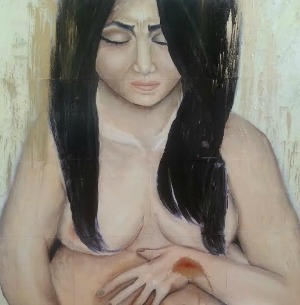On June 20 and 25, our graduating Master of Divinity and MA in Theology & Culture students will present their Integrative Projects, the culmination of their work here at The Seattle School. Until then, we’ll be spotlighting a handful of the presenting students as they reflect on their work—like Matthew Rock’s recent reflections on his project about American incarceration. Here, we talk with Cecelia Romero about her art project, Mujerista: The New Wave.
What’s your Integrative Project all about?
I’ve spent a lot of time trying to sort out my theological beliefs. I grew up with a very specific and robust New Mexican Catholic-type of spirituality, only to have it dismantled in my early twenties in favor of a more homogenous, evangelical faith. I wrestled with the shame of losing what felt like a vital part of my identity in order to try to fit into a place where I really didn’t belong.
Much of my work at The Seattle School has been around racial inclusion and hospitality to the stranger. I have sought to make sense of my own experience as a Millennial Latina woman, considering ways in which I have assimilated to the American culture and also considering specific Latin American cultural nuances, which will always be a part of me.
My Integrative Project is broken into two parts: a series of paintings in which I re-imagine certain women from the Bible through my own cultural and theological lens, and a paper titled “Mujerista: The New Wave” in which I write about the ways in which Mujerista theology has empowered and given voice to millennial Latino and Latina Americans like myself, but also where it has fallen just short of our experience as second, third, fourth generation Americans who feel a sense of displacement and exile within American culture, primarily theologically. Though the project is titled “Mujerista,” it is not focused solely on the experiences of Latina women, but also Latino men, making it more an example of Latino/a theology. I chose the title as a reflection of my personal experience and self-identification.

Painting by Cecilia Romero.
Why is this project so important to you personally?
This work comes out of my self-reflection, trying to figure out who I am—which is the work of this school. It’s also important to me because it feels like something outside of myself. The Latino/a theological voice, as well as the voices from other racial groups, is still very much on the fringes. But as the demographics of our country are changing, these theologies can’t be on the fringes anymore, not if we want the church to be a place that reflects the diversity of the Kingdom.
Personally, I want young Latino/a theologians to have something to engage with. I thought about my brother a lot while working on this project. He’s nine years younger than me and just starting at a Christian college. I want him to have something familiar—something that I felt like I was missing at that age.
What are some of the challenges you faced developing your work?
I felt like I needed to cover all the bases—racism, immigration, assimilation. They all influence the way I am in the world and how people see me, but that wasn’t the heart of the project. I’m third generation American; my family is both assimilated and not. We’re not one thing or the other. I have different values than someone in Mexico, but they’re also different from the perceived “standard American family.”
That sounds like a lonely place to be.
It’s not that I don’t belong anywhere. It’s that there’s this third category that we, I mean Latino/as from backgrounds similar to my own, are not considering. We feel displaced. We don’t know where we belong. We still experience racism and oppression, but we also feel disconnected from our roots—many of us have lost our language, our faith communities, our traditions, etc.—and there’s a lot of shame attached to that. But because of our American heritage and privilege, we also have power to fight for people who don’t have advocates. This project is something of a call. This is who we are, particularly millennial Latino/as. We need to name that, own it, and do what we can with it.
How was the process of trying to express all this through your project?
It’s been long. As students are writing the Integrative Projects, we look back over all our time here. I’ve been writing these papers since my first year, and none of it is tidy—I’ve been all over the map. But knowing that God cares about diversity has driven me and inspired me. That seems like such a simple idea, but it’s something we don’t really talk about: Diversity is a reflection of God and we need it to have a space as disciples. The art piece has been really helpful in that. As I’ve reflected on these women—Mary, the woman caught in adultery, and “talitha cum”—through my mujerista lens, it’s helped me to ground my project theologically.
If you’re intrigued by what you read, we invite you to join us for this year’s presentations, 3-6 p.m. on June 20 and 1-5 p.m. on June 25.

